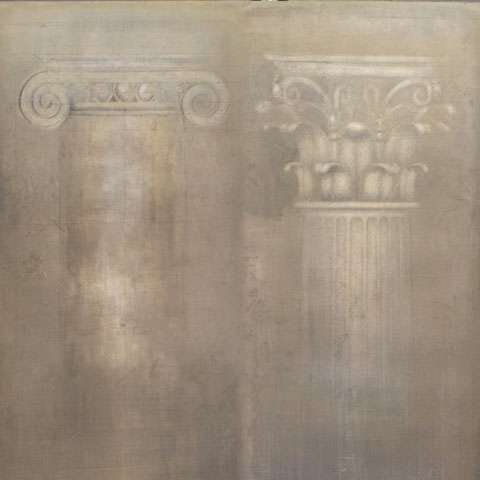
MASTERPIECES
KUPER Yuri Leonidovich (1940) Two columns with capitals: Ionic and Corinthian. Sfumato. 1983. Hardboard, author's technique, box. 203 × 73
Two meters of aesthetic pleasure. It would seem that everything is clear: columns and columns. But in fact — a big philosophical topic. This is a conversation about feminine sophistication and girlish harmony. And, of course, about the beauty of ancient architectural orders, one of which was inspired by the grave of an unnamed poor young woman.
Before us are two columns with different capitals (upper parts). To your left is Ionic. On your right is the Corinthian one. Not enough Doric to illustrate the classification of architectural orders coined by the Roman architectural theorist Vitruvius. The Doric order was associated with the strength of the male body, the Ionic order with female grace, and the Corinthian order with girlish slenderness. In particular, the Ionic columns are part of the Acropolis ensemble in Athens. Corinthian columns adorn the Pantheon in Rome.
The appearance of the Corinthian order is associated with a beautiful legend. They say once (it was 400 years before our era) the ancient Greek master Callimachus was walking around the city of Corinth (remember Paul's letter to the Corinthians?) and came across the grave of a girl from a poor family. According to local custom, a willow basket covered with tiles was placed on the grave. And in this basket the acanthus plant grew. The leaves passed through the twigs and formed a bouquet. Callimachus admired the beauty of this involuntary bouquet and came up with a capital on this model.
And of course, our columns are another example of the masterful embodiment of the sfumato technique that Kuper loves and uses masterly. The technique of blurring, dissolving in air, is believed to be invented by Leonardo da Vinci. It is used in his La Gioconda. And the technique is really amazing. For example, our columns, as it turned out, love the twilight. In the shade, they become more contrasting, bloom. This is a must see.
ZHUTOVSKY Boris Iosifovich (1932) In memory of Ülo. 1970. Oil on hardboard, author's technique. 99 × 79
Boris Zhutovsky, together with Bielutin's studio, participated in the Taganskaya exhibition in November 1962. It was this exhibition that was transported to the Manezh in a few days. And it became the reason for the famous harassment of Khrushchev and the subsequent attack of the authorities on the abstract artists.
Zhutovsky was close to the group of Sretensky Boulevard, which included Kabakov, Neizvestny, Yankilevsky, Pivovarov, Sobolev. One of the brightest figures in this circle of like-minded people was the artist Ülo Sooster. This work is dedicated to him. It addresses the theme of the egg — one of the main themes in Sooster's work. In the memoirs of Anatoly Brusilovsky, there is a mystical story connected with Sooster's egg (see the book “Studio”, pp. 31–32). Once Brusilovsky asked Ülo Sooster to draw him something for memory in the album. Sooster drew an egg. Not simple, but splitting. And inside was a chick. Two weeks later, Sooster was gone. So one of the last, if not the last of his drawing was with an egg with a cracked shell.
A few words about Zhutovsky's technique and philosophy. He uses bio-modified materials. Puts a suspension, and it takes shape according to the laws of nature. That is, nature acts as a co-author. “In Memory of Ülo” is a masterpiece in the work of Zhutovsky. There have been preserved photographs of the participation of this work in exhibitions, including photographs with the artist himself.
INTERESTING STORY
RUKAVISHNIKOV Iulian Mitrofanovich (1922–2000) Seahorse. Sculpture. Bronze. Height 40 cm
Soviet sculptor, academician, people's artist Rukavishnikov erected a stele at the site of the death of Gagarin and Seregin. The busts of Brezhnev and Suslov at the Kremlin wall are his authorship. He created monuments to Kurchatov and Chekhov. Usually they still remember that Rukavishnikov is the author of the tombstone on the grave of Joseph Stalin's mother in Georgia. Well, we remembered the shot when Putin in the Kremlin congratulates Valentina Tereshkova on her anniversary. It's March 2017, and no one knows yet what role Tereshkova will play in strengthening Russian statehood. That in three years the term “zeroing” will appear, amendments to the constitution, and Tereshkova will ask to remove the limitation on the number of terms for Putin. However, we are distracted. Bronze seagull on the right on the table — a gift from Putin to Tereshkova — this is the sculpture “The Seagull Lands on the Water” by Iulian Rukavishnikov. Our “Seahorse” refers to the period when the artist explored the theme of evolution and metamorphosis suggested by nature itself. Back in the mid-1970s, to the great surprise of his colleagues, the successful socialist realist Iulian Rukavishnikov made a turn in his work. And today his name is associated with the renewal in Soviet art.
NONCONFORMIST ART
VECHTOMOV Nikolay Evgenievich (1923–2007) Venus. 1986. Oil on canvas. 70 × 60
Vechtomov was a member of the “Lianozovo group” along with Rabin and Nemukhin. His bright red extraterrestrial compositions are called decorative cosmism and biomorphic surrealism. They really look like something alien. But in reality they were born under the influence of very earthly impressions. From flashes of explosions at the Kursk Bulge and from a flash at the site of the crash of a fighter on a snowy field. Under the influence of the power of art, that traumatic experience was transformed into unnatural surreal landscapes of extraordinary beauty.
ZVEREV Anatoly Timofeevich (1931–1986) Winter landscape. Tree. 1950s. Watercolor on paper. 39.5 × 28 (in light)
Zverev's early drawings are rare. This is the 1950s, when connoisseurs first discovered his talent. And among the connoisseurs were the musician Markevich, Kostaki, and Mstislav Rostropovich. The drawing is two-sided, and it is even difficult for us to choose which side is more subtle and lyrical.
- Log in to post comments










